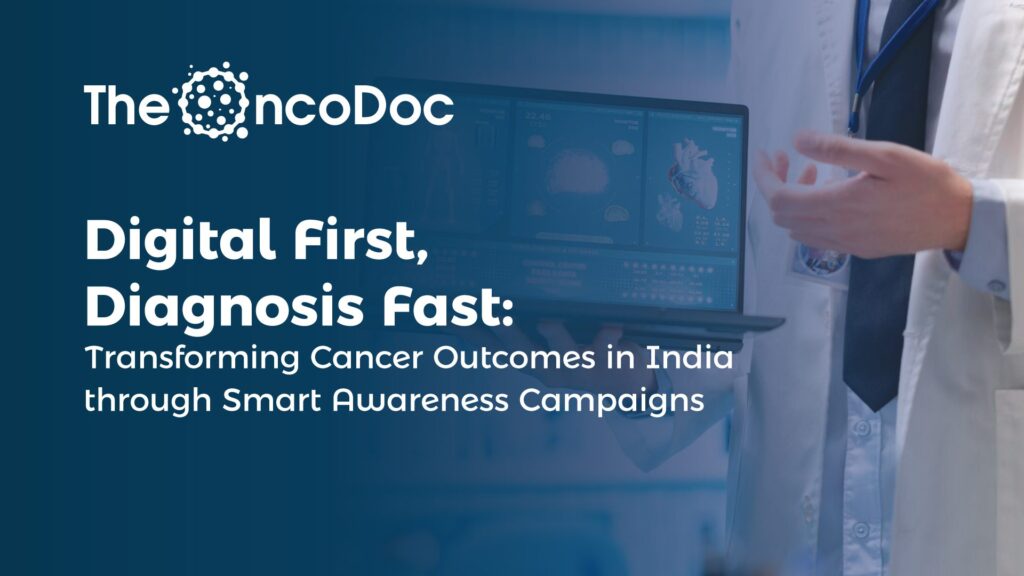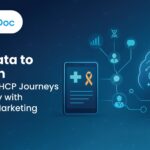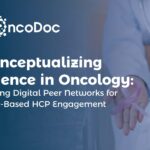Introduction: The Next Frontier in Oncology Marketing
With cancer incidence on the rise and late-stage diagnoses still alarmingly common across India, early detection is no longer a clinical challenge alone; it is a marketing imperative. Traditional campaigns often focus on oncologist engagement or drug launches, but a significant opportunity lies earlier in the patient pathway: timely symptom recognition, accelerated referrals, and public awareness.
Digital platforms ranging from WhatsApp and YouTube to AI-powered chatbots are enabling a new model of health communication. These tools allow pharma marketers to extend their influence from hospital hallways to mobile screens, changing patient trajectories one click at a time.
This article explores how India’s oncology marketers can leverage digital channels to enable earlier cancer diagnosis, build public health impact, and establish long-term brand trust.
1. Bridging the Gap: Why Early Diagnosis Must Be a Digital Priority
According to ICMR, over 70% of cancer patients in India are diagnosed at Stage III or IV. The consequences? Diminished survival, higher treatment costs, and overwhelmed tertiary care centers.
Core barriers to early detection:
- Lack of public awareness on vague symptoms
- Delayed GP referrals due to diagnostic uncertainty
- Cultural stigma and fear of cancer testing
- Inconsistent screening efforts in Tier 2/3 districts

A digital-first strategy designed to educate, empower, and nudge action can reduce these timelines by weeks, even months.
2. Redesigning Public Education: Local, Visual, and Mobile-First
To shift public behavior, content must be
- Visual: Short videos, regional infographics, Instagram reels
- Vernacular: Hindi, Marathi, Tamil, Bengali, not just English
- Empathetic: Survivor stories, myth-busting series, emotional appeal
- Searchable: SEO-optimized landing pages and YouTube content
Examples of public-facing tactics:
- Regional YouTube series like “Is This a Cancer Symptom?”
- Meta ads targeting districts with low screening rates
- WhatsApp symptom checker bots with location-based referral guidance

3. HCP Targeting: Equip GPs, Dentists, and Gynecologists as Frontline Detectors
Most patients don’t walk into oncology clinics; they walk into general OPDs. Equipping generalists with simple, digital symptom tools is a high-impact move.
Key intervention types:
- WhatsApp quiz campaigns with CME credit rewards
- E-mail digests with downloadable symptom posters
- Telegram groups seeded with AI-nudged diagnostic tips
- QR code-based referral flows from primary to tertiary care
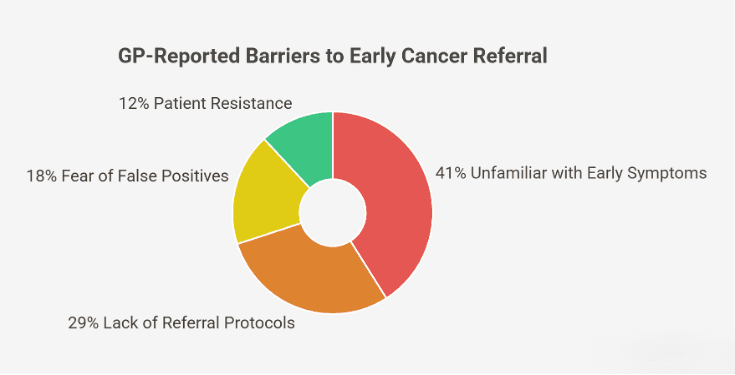
Platforms like Hidoc Dr, Medtalks, and Marrow are ideal partners for distributing micro-learning tools on topics like “When to suspect lymphoma in fever of unknown origin” or “Referral red flags in post-menopausal bleeding.”
4. Partnering with Survivor Influencers and Civil Society
Digital credibility isn’t built through logos it’s built through lived experience. Collaborating with local cancer survivors, patient advocacy groups, and NGOs helps humanize early detection messaging.
Effective partnership formats:
- Reels featuring survivors talking about how early action saved them
- Doctor-patient live sessions on Facebook or YouTube
- WhatsApp-based community groups led by local health workers
- Cross-branded content with NGO logos for trust enhancement
This approach also helps decentralize messaging and reach non-English-speaking populations without losing relatability.
5. AI and Automation: Precision Nudging at Scale
AI can now predict who is most likely to delay screening and intervene proactively. It can:
- Flag low-referral geographies for targeting
- Trigger reminders to GPs based on patient symptom log
- Serve patients with chatbot-driven decision trees
- Use NLP to analyze regional forums for misinformation and address it
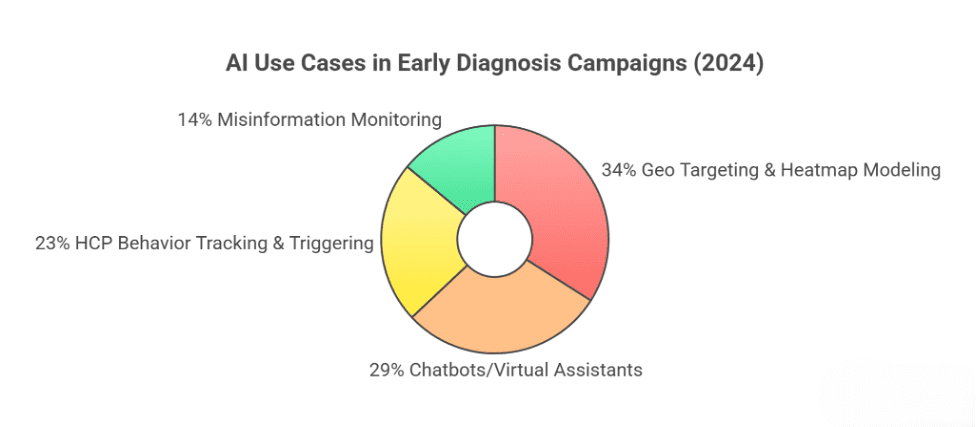
6. Influencing State-Level Health Missions through Digital Policy Pilots
State governments are increasingly open to technology partnerships that improve screening rates.
Pharma marketers can co-develop:
- District-wise heatmaps of referral behavior using anonymized data
- Screening dashboards for Ayushman Bharat district health officers
- Digital training portals for ASHA and ANM workers with early detection checklists
This not only strengthens institutional trust but also embeds early detection messaging into public systems for long-term impact.
7. Measuring What Matters: Awareness to Referral Funnel
Vanity metrics clicks, likes, followers-don’t reflect clinical impact. Oncology awareness programs must map the full behavioral funnel:
From: Awareness → Content Interaction → Symptom Search → Referral Click → Form Fill → Consultation → Confirmed Diagnosis
Tools like Google Analytics, WhatsApp Business API metrics, and integrated CRM dashboards can connect these dots.
Trackable Success Metrics:
- Video watch time (vs. bounce rate)
- GP click-through to referral microsites
- Referral form submissions by pincode
- Repeat visits to symptom checkers
- AI-detected sentiment change in regional forums
8. Building Trust Through Long-Term Content Ecosystems
To move beyond episodic campaigns and toward sustainable impact, oncology marketers must adopt the mindset of content ecosystem architects. Instead of launching fragmented one-off ads or awareness days, brands can build consistent, credible destinations for early detection education.
Content Ecosystem Components:
- Microsites dedicated to specific cancer types (e.g., oral cancer in tobacco-heavy districts)
- Regional blog networks with monthly survivor stories and expert Q&As
- Video series on early warning signs, delivered episodically over weeks
- Monthly WhatsApp newsletters curated by oncologists and family physicians
This layered approach not only supports SEO and recall but builds repeat engagement with patients, caregivers, and primary care providers.
Case Example: Cervical Cancer Microsite Ecosystem (North-East India)
- Localized in Assamese and Bengali
- Video explainers on Pap smears and HPV vaccination
- Embedded chatbot for appointment scheduling
- Resource library for ASHA workers and district gynecologists
Results:
- 84,000+ unique visits in 3 months
- 6,200 screening appointments booked via embedded tools
- 41% engagement rate among rural mobile users (CTR > regional benchmark by 2.5x)
10. Integrating Digital with On-Ground Screening Events
Digital campaigns must extend into the physical world to ensure follow-through. Hybrid outreach models-combining online nudges with offline activation-can bridge the last-mile access gap in cancer screening.
Integrated Tactics:
- Geo-tagged Facebook and Google ads driving footfall to on-ground camps
- QR codes on screening vans linking to patient stories and aftercare guides
- SMS follow-ups post-camp with reports, care instructions, and reminders
- Data capture at camps (name, pincode, contact) feeding into retargeting systems
Such campaigns can also be mapped back to digital dashboards to measure real-world engagement and outcomes.
Hybrid Success Story: Oral Cancer Camps in Telangana
- Sponsored WhatsApp broadcasts 3 days prior to mobile van arrival
- 1.2 lakh impressions, 12,400 link clicks
- 1,100+ people screened, with 137 referrals made
- Post-camp video series saw 3.7x higher retention in target districts
11. Behavioral Science for Campaign Optimization
Digital oncology campaigns are more effective when aligned with human decision-making psychology. Applying behavioral science frameworks can significantly improve messaging, sequencing, and engagement depth.
Key Techniques:
- Loss aversion framing: “Missing a Pap test today could mean treatment tomorrow.”
- Commitment nudges: “Pledge to talk to your GP click here to receive a reminder.”
- Choice simplification: Symptom checkers that use yes/no flows with minimal cognitive load
- Social proof: “Over 10,000 women were screened in your district this month.”
Behaviorally informed campaigns increase not only recall and click-through but also real-world action. This is particularly important for behavior change in asymptomatic individuals who may delay testing.
12. Using Gamification to Sustain Engagement Among HCPs
Frontline clinicians in rural India often face content fatigue. Gamified content-infused with interactivity and micro-rewards-helps improve knowledge retention and sustained participation.
Gamification Strategies:
- Leaderboard-based CME quizzes with regional competitions
- Digital certification badges for referring patients or completing educational modules
- Spin-to-win wheels for ASHAs completing symptom checklist sharing campaigns
- Scenario-based role-play games on platforms like Telegram or MedShr
Such approaches not only drive education but also contribute to morale and informal knowledge sharing among peer groups.
13. Planning for Scale: National Frameworks for Local Campaigns
For maximum reach and policy alignment, early diagnosis efforts must scale with strategic planning. Marketers can build plug-and-play campaign templates tailored to:
- Cancer type (e.g., cervical, breast, oral)
- Language and literacy level
- State-level screening priorities (e.g., Tamil Nadu’s NCD program)
- Seasonal health calendars (e.g., Breast Cancer Awareness Month)
This creates reusability and alignment with institutional health efforts. Brands investing in such repeatable infrastructure position themselves as long-term partners in cancer control.
Conclusion: Toward an Oncology Ecosystem of Early Intervention
India’s oncology burden cannot be addressed solely inside hospitals. Pharma marketers must reframe their role from product pushers to public health partners. By investing in smart, empathetic, and data-driven digital strategies, the industry can meaningfully improve early detection rates, and in doing so, not only save lives but also build trust equity across the care continuum.
This isn’t CSR. This is modern, ethical, high-impact marketing.
Call to Action for Oncology Marketers:
- Deploy multilingual, mobile-first education campaigns
- Build GP referral journeys with digital handholding
- Co-create content with survivors and NGOs
- Use AI to segment, trigger, and optimize outreach
- Measure outcomes in referrals, not reach
- Localize through voice tech and IVR platforms
- Partner with state missions for sustainable deployment
- Integrate digital journeys with physical screening infrastructure
- Embed behavioral design and gamification to sustain engagement
The Oncodoc team is a group of passionate healthcare and marketing professionals dedicated to delivering accurate, engaging, and impactful content. With expertise across medical research, digital strategy, and clinical communication, the team focuses on empowering healthcare professionals and patients alike. Through evidence-based insights and innovative storytelling, Hidoc aims to bridge the gap between medicine and digital engagement, promoting wellness and informed decision-making.

